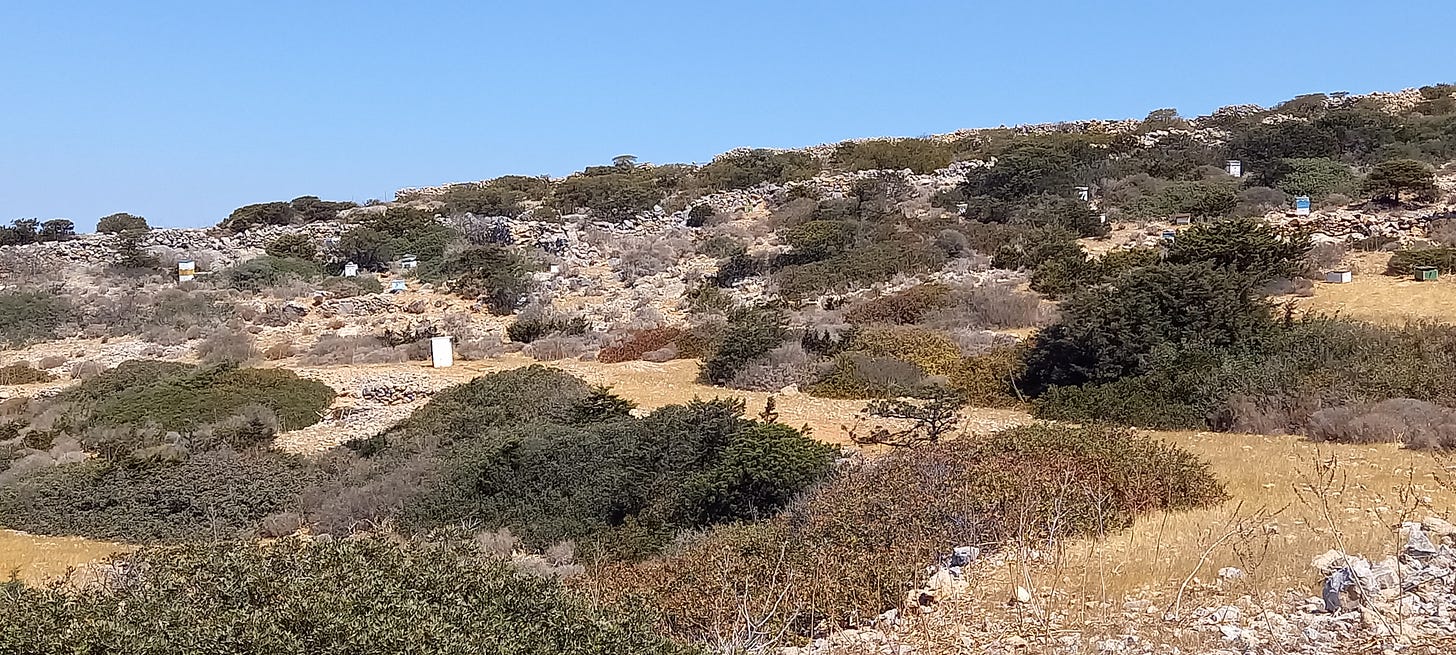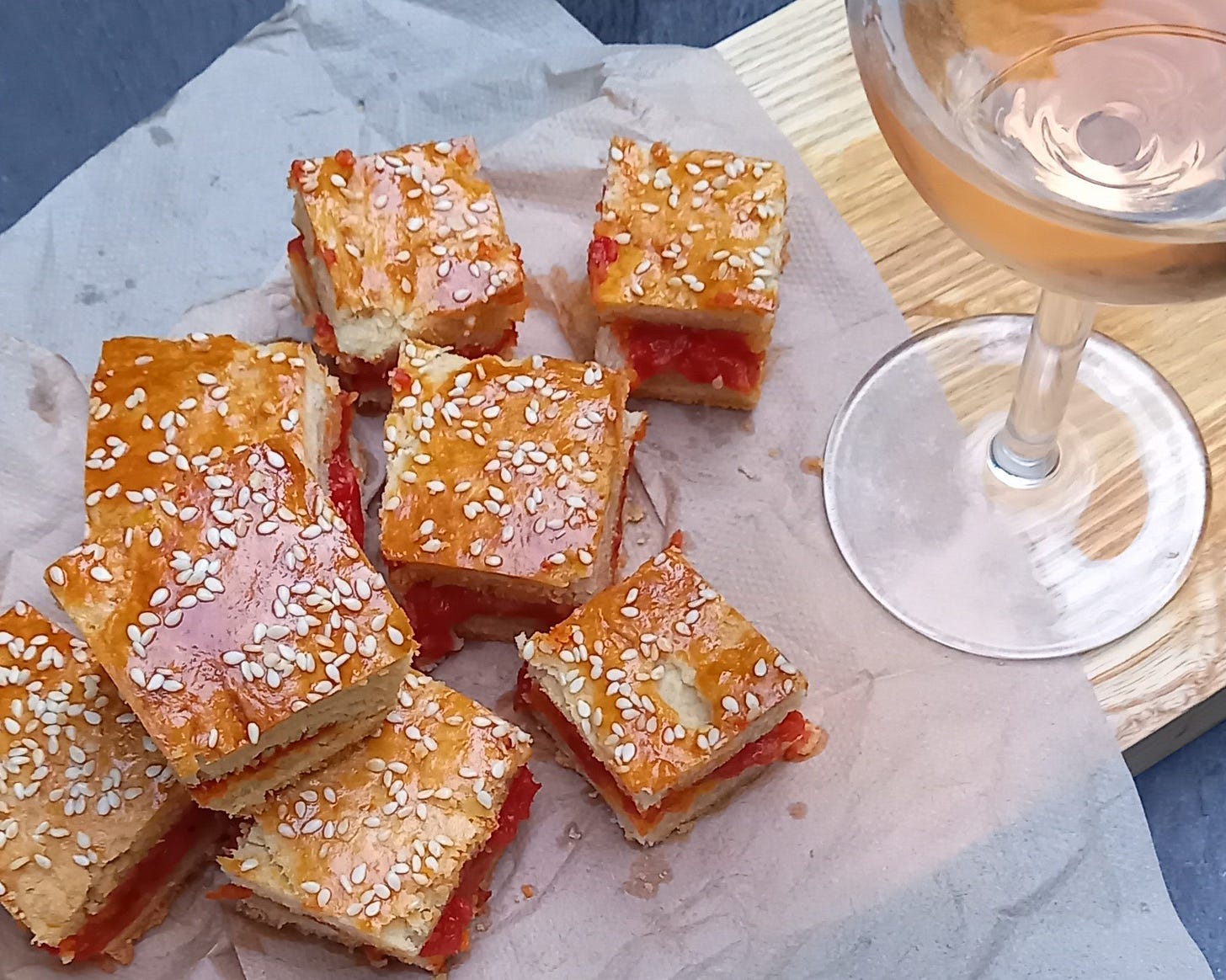In Amorgos, the easternmost island in the Cyclades, Mikis is worried about his bees. The breakfast he and his wife set out at Mike’s Place, their hotel at the tiny port in Aeghiali, offers flower-flavoured honey from his hives to eat with thick Greek yogurt.
But next summer he won’t be able to. Of the 30 hives he harvests from several sites in the hills above the town, only 15 this year have been colonised. The weather has been unseasonably dry - you’ll remember the wildfires around Athens, still visible from the window of my evening flight home. There have been so few sources of pollen for bees to mine that Mikis doesn’t believe he will be getting any honey at all from them.
In addition, Mikis has been made aware of a problem that hasn’t yet reached Amorgos: the fertility of bees that feed off flowers such as rapeseed (Canola or Brassica napus), grown from genetically modified seed and a crop heavily dependent on the herbicides that destroy bees’ natural habitat of wild flowers, is in sharp decline.
If we are not alarmed, we should be. Pollen is the floral equivalent of sperm. 87 of the 115 crops most eaten by us are dependent upon pollination. While some crops such as wheat are pollinated on the wind, 80 percent of the food we eat is the gift of pollinators from butterflies to bees. Without bees, we wouldn’t have apples, cranberries, almonds, melons, broccoli…oh, just wander the produce aisles in your supermarket. Without bees, most of them would be empty. We would not survive.
Forget Lenin, Marx and Engels. The hive could provide the rest of us with a better example of how best to co-exist. It works as a collective, providing each bee with an adequate energy source to live. If they didn’t cooperate, they know they would starve. This is a lesson we seem to have missed.
Honeybees visit up to 1500 flowers to collect enough nectar to fill their honey stomach, a separate stomach in which enzymes begin to break down the nectar into honey. When they return to the hive, it’s regurgitated and chewed by the house bees, so completing the honey-making process.
Your pub quiz question for this week: how much honey does a single bee produce in its lifetime? One twelfth of a teaspoon.
In 2016, when beekeepers around the world began reporting losses of between 30 and 90 percent of their colonies, a bee watch was launched. No-one quite knows the precise cause for Colony Collapse Disorder (CCD), but widespread use of insecticides, ecosystem destruction, and climate change have all been accused.
Vegans who are happy eating raw honey should be particularly concerned if apiarists like Mikis are unable to provide it. The production of industrial honey on which they would be forced to rely is far from vegan-friendly. To harvest maximum honey from commercial hives, when producers remove it they replace the honey with a sugar substitute which, lacking the essential micro-nutrients of honey, is significantly worse for bee health. Commercial bees are bred selectively to increase productivity. This narrows the gene pool and increases susceptibility to disease and die-off.
Natural pollen is so healthy the German Federal Ministry of Health recognizes it as a medicine. The heat and ultrafiltration treatments in commercial production generally remove bee pollen. Raw honey is packed with minerals, vitamins, and more, most of which are processed out of commercial honey. Commercial honey is also likely to contain hidden sugar or sweeteners.
Since I can’t give you a recipe for honey, here is a pie of almost equal nectar - albeit it vegetable not floral. It’s made by Mikis’ wife from tomatoes grown in their garden and was another star of the breakfast table. What I was bowled over by was its κουρου - sorry, still in holiday mode…pastry. It was so short it was almost like Scottish shortbread. I do urge you to have a go because you won’t find it ready-made. And it’s easy. You could use it for any pie, filled as for spanakopitta or tyropitta with spinach or cheese or even, I’m guessing, around a not too liquid fruit compote. I plan to experiment with a slump of plums.
I would eat this tomato pie for breakfast, for lunch, for supper, or cut into small squares as I’ve proposed to go with a cocktail-hour glass of chilled rosé wine or retsina. (Don’t be snobbish about retsina. It’s a Greek holiday in liquid form.)
425g/15oz flour
½ teaspoon sugar
1 teaspoon baking powder
pinch salt
½ tablespoon vinegar
175g/6oz full fat Greek yogurt
150g/5¼ fl oz peanut or vegetable oil
50g/1¾ fl oz olive oil
1 egg yolk
sesame seeds, to sprinkle over
Mix the flour, sugar, baking powder and salt together in a bowl. Add the vinegar, yogurt, olive oil and sunflower oil. Combine all together with a spatula or spoon until the mixture comes together.
For the tomato filling
A slosh of olive oil
1 can peeled tomatoes or some good fresh tomatoes (I’m vague about the amount of the latter as you can always find a use for leftover tomato sauce. If using fresh, since tomatoes can lack punch outside regions of 12-hour sun, feel free to add a spoonful of tomato paste)
salt
teaspoon of sugar (because all cooked tomatoes are improved by the addition of a little sugar)
Small lump of mild feta (optional)
Make a thick tomato sauce by reducing a can of tomatoes, or some really juicy sun-ripe tomatoes blanched to remove their skins, slowly in a little oil over medium heat until you have a thick, spreadable slump. Season with salt and a teaspoon of sugar. If you like, add herbs and finely chopped garlic at the start, but I think it should be about the acidity of the tomatoes contrasting with the rich pastry. Mikis’ wife dotted pea-sized lumps of feta over the tomato paste as she spread it on the pastry, which is a nice lift. But not vital.
Preheat oven to 180C/360F.
Lightly knead the dough but not for too long so it doesn’t release any oil. Cut the lump in two. Roll one out on a floured surface in a rectangle 1/2 cm/1/4 inch thick. Set it onto a baking sheet and repeat with the other. Aim for the same size. They don't need to be exact because you'll trim the pie into squares once cooked. And you’ll eat the trimmings.
Spread the filling thickly over the first sheet then lay the second sheet over. Brush the top with the beaten egg yolk and sprinkle with sesame seeds. Bake for 25-30 minutes, until golden on top and the sides of the pastry look dried out when you trim a test slice off.
Remove from the oven, cut into squares with a serrated bread knife (eating the trimmings as you go) and serve while still warm.
Here’s a picture overlooking the landscape where Mikis’ bees go buzzing to encourage you to try the pastry - and the pie:
Kαλή όρεξη!
PS Re my recipe on Apricot Jam, I have only just found a key correction to my cooking instructions on my Facebook page, posted by fine cook and writer, Zora Margolis. If you’re making the jam, please take note of what she instructs regarding setting temperature, for which I’m very grateful.
Find more newsletters with opinions and recipes here. If you want to take issue, please Comment.








A great Tabled supporter who keeps a firm eye on my maths has emailed the following, which I hope he won't mind me paste-posting here as it's relevant: "…….in the context of a hive there is only limited coexistence. In the autumn, the worker bees, all female, and very much in the majority, decide that they have had enough of the lazy males and stop them entering the hive after they have taken their daily flight for exercise. Result : dead drones below the hive. Sensible. But I am not sure that the three named males (Lenin, Marx, Engels) would have agreed." Sounds familiar...
Your post is very pertinent. Today there was an article in our local paper in Garmisch-Partenkirchen (Germany) about the honey crop which was very poor to non-existent throughout the region this year. The article attributed the failure to weather, but I'm sure some of the environmental factors you mention come into play here as well.
It is truly a disheartening thing to contemplate.